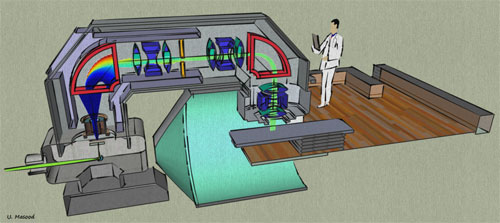
Drawing of the proposed proton-therapy facility. (Courtesy: Umar Masood)
By Hamish Johnston
In the 25th anniversary issue of Physics World, I made the bold assertion that laser acceleration will bring particle therapy to the masses by removing the need for treatment centres to have large and expensive accelerators. Instead, therapeutic beams of protons and other charged particles will be made using compact and relatively inexpensive lasers.
Now, medical physicist Umar Masood and colleagues at the Helmholtz-Zentrum Dresden-Rossendorf (HZDR) and the University of Dresden have published plans for a laser-driven proton-therapy facility.
Pictured in the drawing above, the facility is about half the size of a conventional accelerator-based unit. An important feature of the device is that it delivers a proton beam with a much wider spread of energies than an accelerator. While this is not ideal for conventional treatment methods, Masood points out that it could actually be an advantage.
Mono-energetic proton beams are used for treating some cancers because they kill tumours while sparing the surrounding healthy tissue. This is because most of the lethal energy of the protons is delivered to tissue at a very specific depth under the skin. Therapy often involves changing the energy of the beam, which changes the depth at which the lethal energy is delivered and ensures that the entire tumour is destroyed. In principle, a laser-generated proton beam with a wider spread of energy would kill tumour cells over a wider range of depths, thereby eliminating the need to scan the beam energy.
The high-energy protons themselves are created by firing laser pulses at a gaseous target that’s only a few millimetres in size. The challenge for Masood was to reduce the size of the “gantry”, which focuses and guides the protons to the patient. While gantries in accelerator-based systems can be the size of a small house, the pulsed nature of a laser system means that its gantry could be made much smaller.
But there is much more work to be done, including the development of compact-yet-powerful gantry magnets that operate in a pulsed mode. Researchers must also work out ways of boosting the energy of the laser-accelerated protons, which is currently not high enough for some therapeutic applications.
You can read more about Masood’s design here and in this paper published in Applied Physics B.
My predictions for laser-driven proton therapy and other promising physics spin-offs are in an article called “Physics for our future”. It begins on page 52 of the October 2013 issue of Physics World, which you can download a PDF of here. And there is much more about particle therapy in our article “Damage limitation”.
The Laser-driven Ion Beam Therapy (L-IBT) is, indeed, an attractive alternative to the conventional particle therapy facilities. However, this system has to overcome the present lack of enough proton beam intensity and beam energy.
Trackback: Physics Viewpoint | Proton therapy is for the masses
dear sir, i need one answer of this question if you help i am very thankful to you.
question: Red light of wavelenght 6400 A is made to fall in sodium metal with work function of 2.46 eV.
Eplain why no photocurrent can be observed?